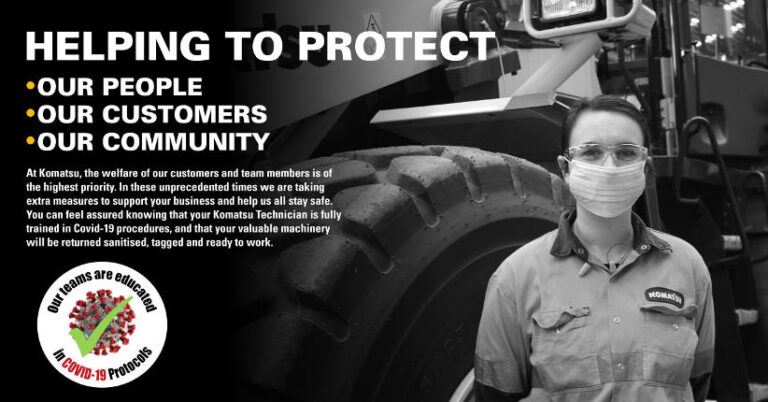Higher work productivity and efficiency of solutions in supply-chain management as well as machinery maintenance in the mining and construction industries are likely to become permanent outcomes of response to the COVID-19 pandemic.
A greater emphasis on agile supply chain methods, a ramping up of E-commerce ordering, greater reliance on sophisticated machine monitoring allied to customer support centres, and the flexible deployment of key staff to areas of immediate need, have all become part of a rapid evolution process over the course of just two months.
And, while they have in the main achieved their goal of maintaining business as usual, particularly in essential service industries, there is every likelihood that business in the future will be conducted in a different and even more failsafe manner.
“We are already planning for life after COVID-19 and it will contain efficiencies which we have developed as a response to the pandemic,” Komatsu Australia’s Executive General Manager of People and Strategy, Colin Shaw said.
Komatsu is a major supplier of below and above ground heavy machinery.
The post-COVID-19 plan will address not only the needs of large mining and construction companies, but also those of smaller plant operators who may need assistance to readjust their businesses.
Some new processes which had been introduced only recently have been tested and refined by the urgency of the pandemic response, well in advance of normal roll-out procedures.
According to Todd Connolly, Komatsu’s General Manager of Construction Solutions, use of the my.komatsu.com.au, automated parts ordering portal had nearly doubled during the COVID 19 response. The contactless purchasing process had been well received by new and existing customers alike, Mr. Connolly said.
The portal was launched only a year ago and according to Connolly, had proved robust under the unexpected load of the COVID-19 response.
Use of the company’s KCSC (Komatsu Customer Support Centre), a two-way communication, had increased significantly as customers and Komatsu sought alternatives to face-to-face contact.
The KCSC is supported by Komatsu’s extensive use of Information Communication Technologies (ICT) including KOMTRAX on-board monitoring service with real time assessment of machinery performance.
Both initiatives had been supported by substantial change to the company’s parts supply chain process, optimising the relationship between regional branches and centralised Distribution Centres by the use of predictive modelling techniques.
When New Zealand lock down laws were enacted, Komatsu Australia had rapidly moved to provide parts to its entire New Zealand network from its Wacol, Brisbane hub.
Freight forwarding had occurred with almost no disruption as a result of careful monitoring of transport solutions.
“People have been at the heart of our COVID-19 strategy,” Mr. Shaw said.
More than two thirds of Komatsu’s Australian and New Zealand total workforce of 3,400 has continued to provide service and manufacturing functions in the company’s plants and in the field, while office staff in the main have worked from home.
A recently inaugurated “Start Safe” policy intended to meet and exceed workplace safety requirements, had adapted well to the current challenge.
Mr. Shaw said the company had worked with the Minerals Council of Australia to ensure that recommended protocols met industry standards during this special situation.
“Meticulous process detail goes right to the heart of good customer relations,” Mr. Shaw said. “Once a machine has been serviced and cleaned, a tag indicates its condition, which gives customer’s confidence that every consideration has been taken to ensure the health of their employees.
Komatsu’s technicians have been COVID-19 trained and certified. Paramedics had been employed at key manufacturing sites and split shift protocols had been introduced ranging from separated workplaces and crib rooms through to designated machinery disinfection time between major operations.
Customer communication had identified potential areas of vulnerability in their operations and Komatsu had worked directly with its staff to find solutions.
“A flying squad of technical experts was moved from Western Australia to Queensland in recognition that members might be isolated for some time and that on-ground local support is far more efficient in current times,” Mr. Shaw said. “Paramount was the ability of our people to make that commitment without putting their family or personal requirements at risk,” he said.
Komatsu Australia now has a supply-chain task force with access to global factories to visualise and plan responses to the fast-moving consequences of the pandemic.
“At any moment, we have more than a dozen potential scenarios in planning to ensure that our response time is minimised, and that we are not totally reactionary,” Mr. Shaw said. “We are learning a lot and already our findings are being translated into new training programs that will pass through our network.”






